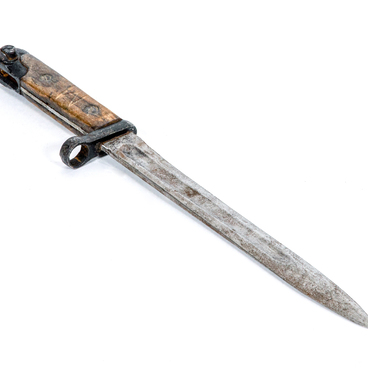This 1891/1930 Mosin’s rifle was produced in 1943 at the Izhevsk Mechanical Plant. It was transferred to the Noyabrsk museum in 2014: it was acquired as part of the ‘Russian weaponry makers’ museum project. In order to become a museum exhibit, the service rifle had to be deactivated at a factory — a number of irreversible changes were made to all the main components of the rifle. Such weapon units are often called mass-dimensional models.
The Mosin’s Rifle was adopted by the Russian military in 1891. It is also known as the ‘3-line rifle’, as the caliber of the barrel is equal to three Russian lines. The (Russian) line is an old unit of length, equal to one tenth of an inch, or 2.54 millimeters. Thus, three lines are equal to 7.62 millimeters.
The 3-line rifle was very easy to use. Even those people who had not undergone any military training could fire this rifle. Besides, no special qualifications were required for its production. The main parts of this rifle are the barrel, the receiver, the magazine and the ejector, the trigger, the bolt, the stock, the handguard and iron sights.
Four up- and right-turning grooves are inside the barrel. They cause the bullet to spin, producing a more stable flight path. In the rear part of the barrel is a chamber where the cartridge is inserted before firing. The receiver and the bolt are screwed on tight in the back. The 4-round magazine with the feed system, the ejector and the trigger are attached to the receiver.
The interrupter separates the cartridges (that are fed from the magazine), prevents delay in feeding and expels the spent casings. The trigger mechanism of the rifle consists of a trigger blade, a trigger spring, a screw and a trigger pin. The spring also serves as the sear that holds the firearm at half-cock until the right amount of pressure is applied to fire the rifle. This rifle has a long heavy trigger pull without the ‘warning’: it does not perform in two stages, which differ in the applied pressure. With the help of the bolt, the cartridge is fed from the magazine into the chamber, and at the moment of firing, the bore closes, the rifle is fired, and then the spent shell (or a misfired cartridge) is removed.
The stock connects the parts of the weapon, it consists of a for-end, a grip and a butt. The stock was normally cut from a single piece of wood. In the early models of the rifle, the grip that was used by the rifleman to hold the weapon was straight and firm, which was more suitable for bayonet fighting rather than artillery fire. For the models produced in the 20th century, a semi-pistol grip was incorporated.
The Mosin’s Rifle was adopted by the Russian military in 1891. It is also known as the ‘3-line rifle’, as the caliber of the barrel is equal to three Russian lines. The (Russian) line is an old unit of length, equal to one tenth of an inch, or 2.54 millimeters. Thus, three lines are equal to 7.62 millimeters.
The 3-line rifle was very easy to use. Even those people who had not undergone any military training could fire this rifle. Besides, no special qualifications were required for its production. The main parts of this rifle are the barrel, the receiver, the magazine and the ejector, the trigger, the bolt, the stock, the handguard and iron sights.
Four up- and right-turning grooves are inside the barrel. They cause the bullet to spin, producing a more stable flight path. In the rear part of the barrel is a chamber where the cartridge is inserted before firing. The receiver and the bolt are screwed on tight in the back. The 4-round magazine with the feed system, the ejector and the trigger are attached to the receiver.
The interrupter separates the cartridges (that are fed from the magazine), prevents delay in feeding and expels the spent casings. The trigger mechanism of the rifle consists of a trigger blade, a trigger spring, a screw and a trigger pin. The spring also serves as the sear that holds the firearm at half-cock until the right amount of pressure is applied to fire the rifle. This rifle has a long heavy trigger pull without the ‘warning’: it does not perform in two stages, which differ in the applied pressure. With the help of the bolt, the cartridge is fed from the magazine into the chamber, and at the moment of firing, the bore closes, the rifle is fired, and then the spent shell (or a misfired cartridge) is removed.
The stock connects the parts of the weapon, it consists of a for-end, a grip and a butt. The stock was normally cut from a single piece of wood. In the early models of the rifle, the grip that was used by the rifleman to hold the weapon was straight and firm, which was more suitable for bayonet fighting rather than artillery fire. For the models produced in the 20th century, a semi-pistol grip was incorporated.



